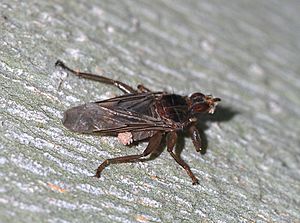Commensalism facts for kids
Commensalism is a cool type of relationship between two different living things. In this partnership, one organism gets something good out of it, like food or a place to live. But the other organism isn't helped or harmed at all. It just goes about its business!
This is different from mutualism, where both organisms benefit from each other. Think about it: some birds might live in holes in trees. Does this hurt the tree? Probably not. Or tiny mites, which can't fly, might catch a ride on an insect. Does this bother the insect? Not usually.
You can also see commensalism with plants. Orchids, mosses, and lichens often grow on tropical trees. They need sunlight to grow, and by being high up on the tree, they get plenty of sun. The tree keeps living and growing just fine, so these plants (called epiphytes) don't seem to affect their host tree.
The idea of commensalism was first talked about in the 1870s by a scientist named Pierre-Joseph van Beneden.
What is Amensalism?
Amensalism is another type of relationship, but it's a bit different from commensalism. In amensalism, one organism is harmed or stopped from growing, while the other organism isn't affected at all.
Here are some examples:
- Imagine a tall, wide plant growing over a smaller plant. The big plant blocks the sunlight from the small one, which harms the smaller plant. But the big plant doesn't care about the small one at all.
- Some plants release special chemicals into the soil. These chemicals can stop other plants from growing nearby. This is called allelopathy. The plant releasing the chemicals isn't affected, but the other plants are harmed.
Related topics
Images for kids
-
Remora fish attach to larger fish like sharks. They get a free ride and eat leftover food.
-
Inquilinism: Tillandsia bourgaei is a plant that grows on an oak tree in Mexico. It uses the tree for support but doesn't harm it.
See also
 In Spanish: Comensalismo para niños
In Spanish: Comensalismo para niños



